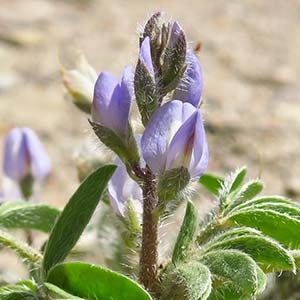Lupinus pusillus
Lupinus argenteus
intermountain lupine, low lupine, rusty lupine
silvery lupine
short and tufted or erect, branched from base or near middle.
erect or ascending, green or purplish, clustered, branched or unbranched.
cauline, often crowded near base;
stipules well developed;
petiole 1–9 cm;
leaflets 5–9, blades 10–40 × 5–10 mm, adaxial surface glabrous.
basal and/or cauline;
stipules 2–12 mm;
petiole 1–15 cm;
leaflets (5 or)6–10, blades 10–60 × 4–10 mm, abaxial surface hairy, adaxial surface glabrous or hairy (but not strigose).
8–12-flowered, 2–11 cm, shorter than or slightly exceeding foliage;
flowers spirally arranged.
loose, 5–16(–25) cm;
flowers whorled or not.
0–3.5 cm;
bracts persistent, straight, 2–5 mm.
(1–)4–25(–30) cm;
bracts usually deciduous, 3–4 mm.
1–3.5 mm.
(1–)2–5(–7) mm.
5–12 mm;
calyx abaxial lobe entire, 5–6 mm, adaxial lobe cleft, 2.5–4 mm;
corolla vivid blue, sometimes paler or white, sometimes bicolored, banner spot white or yellowish, keel glabrous.
5–15 mm;
calyx 4–8 mm, bulge or spur 0–3 mm (may be variable on plant), abaxial lobe entire or 3-toothed, adaxial lobe entire or 2-toothed;
corolla usually blue, sometimes purple, violet, pink, lilac, or white, banner patch yellowish to whitish, blue, brown, or absent, banner not much reflexed-recurved beyond midpoint, this less than 3 mm proximal to apex, banner glabrous or pubescent abaxially, wings glabrous, lower keel margins glabrous, upper margins ciliate.
1.5 cm, constricted between seeds, thinly pilose to coarsely hirsute.
(1–)2–3 cm, hairy or silky.
persistent, disclike, sessile.
deciduous, petiolate.
2, wrinkled or ridged.
(2 or)3–5(or 6), tan, brown, or red.
Lupinus pusillus
Lupinus argenteus
Varieties 3 (3 in the flora).
Lupinus pusillus is a highly variable species, with the varieties intergrading.
(Discussion copyrighted by Flora of North America; reprinted with permission.)
Varieties 14 (14 in the flora).
(Discussion copyrighted by Flora of North America; reprinted with permission.)
1. Peduncles 0–1 cm; racemes shorter than foliage; flowers 6–8 mm. | var. intermontanus |
1. Peduncles usually 1–3.5 cm; racemes equal to or longer than foliage; flowers 7–12 mm. | → 2 |
2. Pedicels and calyx tubes strigose. | var. pusillus |
2. Pedicels and calyx tubes glabrous. | var. rubens |
1. Calyx spur 1–3 mm. | → 2 |
2. Flowers in profile appearing open, spur pronounced. | var. heteranthus |
2. Flowers in profile appearing closed; spur less pronounced. | → 3 |
3. Petioles of proximal cauline leaves 1.5–3 cm. | var. argophyllus |
3. Petioles of proximal cauline leaves 3–12 cm. | var. utahensis |
1. Calyx bulge 0–1 mm, but not elongated into a spur. | → 4 |
4. Leaflets oblanceolate, flat, green, surfaces glabrous or adaxially pubescent; plants of cool, moist mountain meadows, stream banks, lakeshores. | → 5 |
5. Corollas pale blue with brown banner patch; pedicels 1–2.5 mm. | var. fulvomaculatus |
5. Corollas usually blue with yellow banner spot or none; pedicels usually 3–4 mm. | → 6 |
6. Stems unbranched and racemes solitary, terminal. | var. rubricaulis |
6. Stems branched, giving rise to several racemes. | → 7 |
7. Corolla wings (7.5–)8–10 mm. | var. argentatus |
7. Corolla wings 5–7.5 mm. | var. parviflorus |
4. Leaflets oblanceolate or elliptic-oblanceolate, narrow and often folded, surfaces gray or silver-pubescent; plants of dry open areas, foothills to mountains. | → 8 |
8. Stem hairs descending in backward direction or widely spreading. | var. palmeri |
8. Stem hairs forwardly appressed. | → 9 |
9. Flowers large, (7–)8–15 mm. | → 10 |
10. Basal and cauline leaves present at flowering. | var. montigenus |
10. Basal leaves absent at flowering. | → 11 |
11. Flowers (7–)8–12 mm. | var. argenteus |
11. Flowers 12–15 mm. | var. moabensis |
9. Flowers small, 5–7(–9) mm. | → 12 |
12. Banners densely pubescent. | → 40g |
40g. Lupinus argenteus var. holosericeus. | → 12 |
12. Banner glabrous or thinly strigulose abaxially. | → 13 |
13. Wings 5.5–7 mm; banner usually thinly strigulose abaxially; Kaibab Plateau, Arizona, Colorado, Nevada, New Mexico, Utah; elevation 2000–2800 m. | var. hillii |
13. Wings 5–6 mm; banner glabrous abaxially; Sierra Nevada, California, adjacent Nevada; elevation 1500–3500 m. | var. meionanthus |
